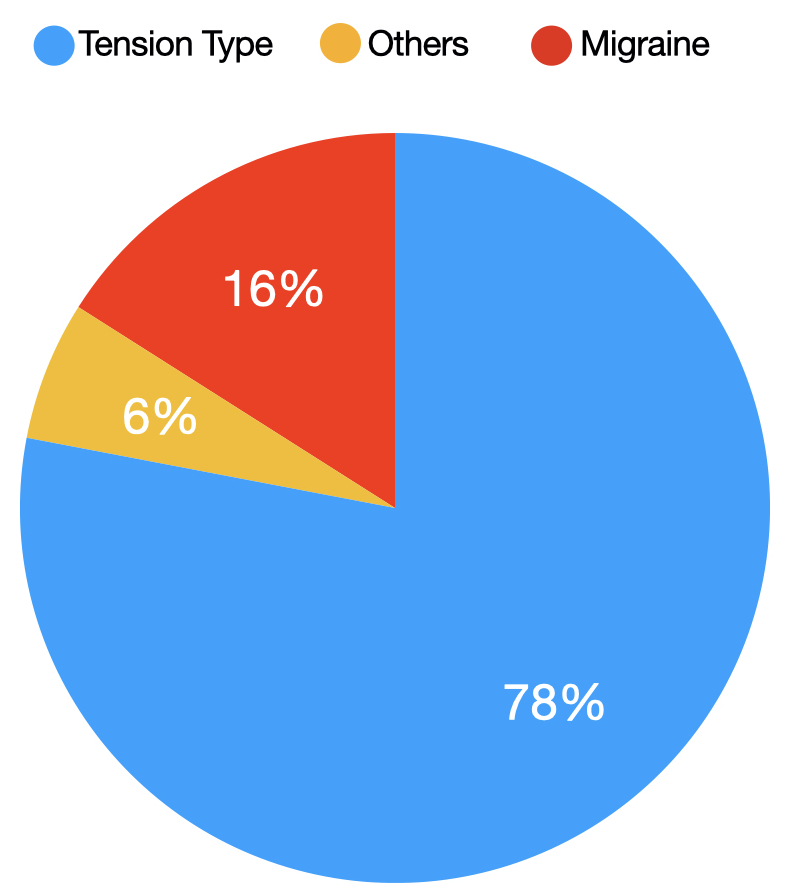Headache means a symptom of pain in the region of head or neck
>200 causes
Unless we know for sure what causes the headache how can we treat?
- Primary Headaches 90%
- Secondary Headaches 10%
Majority of the times, headaches are benign. That’s where a role of Headache Specialist comes. They listen to your symptom profile, do a detailed neurological examination (including fundus examination), analyse, group and categorize your headache type. This is the most crucial step in headache management.
If you choose a wrong train, you’ll get wrong stations.
Primary Headaches
Not dangerous, No Structural CausesGeneral Population

People who go to a Doctor

Though Tension Type headache is most common headache experienced in a given general population, but of the people who visit a doctor, Migraine is the most common headache. Either, Tension Type headache is so mild or non disabling that people choose not to go to a doctor or Migraine headaches are so disabling that one has to seek a doctor .
Migraine
Most often begins at puberty and most affects those aged between 35 and 45 years.
Migraine is recurrent, often life-long, and characterized by attacks.
Attacks include features such as
headache of moderate or severe intensity;
nausea (the most characteristic);
one-sided and/or pulsating quality;
aggravated by routine physical activity;
with duration of hours to 2-3 days;
attack frequency is anywhere between once a year and once a week; and
in children, attacks tend to be of shorter duration and abdominal symptoms more prominent.
Most often begins at puberty and most affects those aged between 35 and 45 years.
Migraine is recurrent, often life-long, and characterized by attacks.
Attacks include features such as
headache of moderate or severe intensity;
nausea (the most characteristic);
one-sided and/or pulsating quality;
aggravated by routine physical activity;
with duration of hours to 2-3 days;
attack frequency is anywhere between once a year and once a week; and
in children, attacks tend to be of shorter duration and abdominal symptoms more prominent.
Tension-type headache (TTH)
Most common primary headache disorder.
Episodic TTH is reported by more than 70% of some populations; chronic TTH affects 1-3% of adults.
TTH often begins during the teenage years, affecting three women to every two men.
Its mechanism may be stress-related or associated with musculoskeletal problems in the neck.
Episodic TTH attacks usually last a few hours, but can persist for several days.
Chronic TTH can be unremitting and is much more disabling than episodic TTH.
This headache is described as pressure or tightness, like a band around the head, sometimes spreading into or from the neck.
Most common primary headache disorder.
Episodic TTH is reported by more than 70% of some populations; chronic TTH affects 1-3% of adults.
TTH often begins during the teenage years, affecting three women to every two men.
Its mechanism may be stress-related or associated with musculoskeletal problems in the neck.
Episodic TTH attacks usually last a few hours, but can persist for several days.
Chronic TTH can be unremitting and is much more disabling than episodic TTH.
This headache is described as pressure or tightness, like a band around the head, sometimes spreading into or from the neck.
Cluster Headache (CH)
Affects fewer than 1 in 1000 adults, affecting six men to each woman.
Age: 20s or older.
It is characterized by frequent recurring, brief but extremely severe headache associated with pain around the eye with tearing and redness, the nose runs or is blocked on the affected side and the eyelid may droop.
Episodic and chronic forms.
Affects fewer than 1 in 1000 adults, affecting six men to each woman.
Age: 20s or older.
It is characterized by frequent recurring, brief but extremely severe headache associated with pain around the eye with tearing and redness, the nose runs or is blocked on the affected side and the eyelid may droop.
Episodic and chronic forms.
Secondary Headaches
Many Harmless, some dangerous. Many have underlying cause.Headaches may be caused by problems elsewhere in the head or neck. They have to be thoroughly investigated and treated accordingly. Some of these are not harmful, such as cervicogenic headache (pain arising from the neck muscles).
More serious causes of secondary headaches include:
- Meningitis: inflammation of the meninges which presents with fever, vomiting and stiff neck.
- Brain Hemorrhage: bleeding inside the brain.
- Subarachnoid Hemorrhage: acute, severe headache, stiff neck WITHOUT fever due to rupture of blood vessel in brain.
- Brain Tumor: dull headache, worse with exertion and change in position, accompanied by nausea and vomiting. Often, the person will have nausea and vomiting for weeks before the headache starts.
- Temporal Arteritis: inflammatory disease of arteries common in the elderly (average age 70) with fever, headache, weight loss, jaw claudication, tender vessels by the temples, polymyalgia rheumatica. ESR increased in blood test.
- Acute closed angle Glaucoma (increased pressure in the eyeball): headache that starts with eye pain, blurry vision, associated with nausea and vomiting. On physical exam, the person will have a red eye and a fixed, mid dilated pupil.
Medication-overuse headache (MOH)
- caused by chronic and excessive use of medication to treat headache. Yes, PARADOXICAL.
- most common secondary headaches.
- It may affect up to 5% of some populations, women more than men.
- MOH is oppressive, persistent and often at its worst on awakening.
References
- Dowson A, Dahlof C, Tepper S, Newman L. Prevalence and diagnosis of migraine in a primary care setting. Cephalalgia. 2002;22:590-591.
- Rasmussen BK, Jensen R, Schroll M, Olesen J. Epidemiology of headache in a general population — a prevalence study. J Clin Epidemiol. 1991;44:1147-1157.
- WHO- Headache Disorder Fact Sheet

